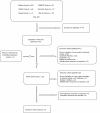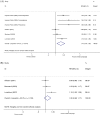Do mass media campaigns improve physical activity? a systematic review and meta-analysis
- PMID: 23915170
- PMCID: PMC3737034
- DOI: 10.1186/0778-7367-71-20
Do mass media campaigns improve physical activity? a systematic review and meta-analysis
Abstract
Background: Mass media campaigns are frequently used to influence the health behaviors of various populations. There are currently no quantitative meta-analyses of the effect of mass media campaigns on physical activity in adults.
Methods: We searched six electronic databases from their inception to August 2012 and selected prospective studies that evaluated the effect of mass media campaigns on physical activity in adults. We excluded studies that did not have a proper control group or did not report the uncertainties of the effect estimates. Two reviewers independently screened the title/abstracts and full articles. We used random-effects models to pool effect estimates across studies for 3 selected outcomes.
Results: Nine prospective cohorts and before-after studies that followed-up 27,601 people over 8 weeks to 3 years met the inclusion criteria. Based on the pooled results from these studies, mass media campaigns had a significant effect on promoting moderate intensity walking (pooled relative risk (RR) from 3 studies=1.53, 95% Confidence Interval: 1.25 to 1.87), but did not help participants achieve sufficient levels of physical activity [4 studies pooled RR=1.02, 95% CI: 0.91 to 1.14)]. The apparent effect of media campaigns on reducing sedentary behavior (pooled RR=1.15, 95% CI: 1.03 to 1.30) was lost when a relatively low-quality study with large effects was excluded in a sensitivity analysis. In subgroup analyses, campaigns that promoted physical activity as a 'social norm' seemed to be more effective in reducing sedentary behavior.
Conclusion: Mass media campaigns may promote walking but may not reduce sedentary behavior or lead to achieving recommended levels of overall physical activity. Further research is warranted on different campaign types and in low- and middle- income countries.
Figures




References
-
- Lim SS, Vos T, Flaxman AD, Danaei G, Shibuya K, Adair-Rohani H, Amann M, Anderson HR, Andrews KG, Aryee M. et al.A comparative risk assessment of burden of disease and injury attributable to 67 risk factors and risk factor clusters in 21 regions, 1990—2010: a systematic analysis for the global burden of disease study 2010. Lancet. 2012;380(9859):2224–2260. doi: 10.1016/S0140-6736(12)61766-8. - DOI - PMC - PubMed
-
- Bull FC, Armstrong T, Dixon T, Ham S, Neiman A, Pratt M. In: Comparative quantification of health risks : global and regional burden of diseaseattributable to selected major risk factors. Ezzati M, Alan D, Lopez AD, Rodgers A, Murray CJL, editor. Geneva: World Health Organization; 2004. Physical inactivity; pp. 730–881.
LinkOut - more resources
Full Text Sources
Other Literature Sources
Miscellaneous

